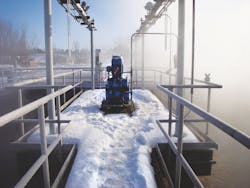Aging infrastructure, restricted capacity and limited funding—it is a familiar story in the world of municipal wastewater treatment plants. Many cities today are facing the same challenges and looking for ways around the need for increased services in the face of reduced resources. Antiquated systems are difficult to maintain and expensive to run, making it hard for cities to provide necessary services, grow or add needed revenue.
Rebuilding Rome
Rome, N.Y., was one of these cities. Aptly named after the ancient empire, known for its aqueducts and amazingly modern (for the time) approach to water and wastewater, Rome is located in upstate New York just east of Syracuse.
A few years ago, the city of almost 35,000 people faced all of the typical problems associated with an outdated wastewater treatment plant (WWTP). The 30-year-old mechanical aerators were so old that custom-made replacement parts had to be ordered a year in advance at prohibitively high costs. The system was inefficient, with high energy bills, and it lacked the capacity to raise additional revenue by treating companies’ or other municipalities’ wastewater. The city needed to update the facility, but did not want to raise rates or taxes on a citizenry that already was dealing with the effects of the recession.
A few years earlier, Rome had worked with an energy service company (ESCO) on $2 million worth of energy-efficiency upgrades for city-owned buildings, including its city hall, central fire station, police department offices and the Rome Arts Center. These upgrades included installing new boilers, high-efficiency lighting and automated energy management systems. Using a self-funded “performance contract” meant the improvements would pay for themselves through lower utility bills.
An Energy Saving Performance Contract guarantees that improvements to a building or facility will deliver a certain amount of water and energy savings over a fixed period of time. The costs of facility and infrastructure retrofit or renewal projects can be offset by the energy and operational savings that are achieved as a result. If the ESCO does not reach the guaranteed savings, it pays the difference between what was guaranteed and what was actually saved.
Based on Rome’s first success with performance contracting, the city teamed up again with the same ESCO to modernize its WWTP. This time, the city was able to use the state of New York’s performance contracting legislation to finance the project with a tax-exempt, 15-year term municipal lease.
The city’s goals were to:
- • Modernize the WWTP, making repairs, maintenance and operation more efficient and less costly;
- • More easily and efficiently meet discharge permit requirements;
- • Save energy and reduce utility bills;
- • Increase capacity so that the facility could raise revenues by treating additional waste from other cities and businesses;
- • Increase capacity for future growth; and
- • Keep rates and taxes down for city residents.
Replacement of the antiquated aeration system with fine bubble aeration devices that included energy-efficient variable-vane blowers, dissolved oxygen controls and membrane diffusers began Rome’s series of WWTP upgrades. The dissolved oxygen controls automate the output of the blowers, minimizing energy consumption. Variable-speed drives also were installed on all low-lift pumps at the plant.
Using New York’s performance contracting legislation gave Rome city officials more control and flexibility than other financing methods. It gave the facility the freedom to go beyond replacing equipment by selecting updated technologies that could add real value and efficiency to the system. The result was a WWTP that could operate more efficiently while maintaining quality and meeting discharge permit requirements.
The performance contract guaranteed the city about $100,000 in annual utility cost savings and $8.6 million in savings over the 15-year term. Since the 2009 upgrades, the facility has continued to outperform, saving the city substantially more than projected in energy costs. The energy savings are expected to continue after the end of the contract, with all of the savings going directly to the city.
Ample Benefits
In addition to utility cost savings, the upgrades at the WWTP have allowed the city to expand its capacity so that it can increase revenue by treating additional wastes from other counties or municipalities—Rome pays for the upgrades with energy savings and adds an additional source of income. That has put the WWTP in a good position for future growth and can help the city to attract new businesses and residents. At the same time, the performance contracting financing meant that the city did not have to increase water rates or taxes.
It is important to remember that Rome not only modernized its WWTP, saved money and created a new revenue stream by treating other wastes—it also reduced its carbon footprint and helped the environment, something many cities are eager to do. In fact, the city has received recognition for its efforts and the project was named 2009 Environmental Protection Project of the Year by the American Public Works Assn.
The city of Rome is an example of what budget-conscious municipalities can do to modernize aging wastewater treatment facilities. Many cities are experiencing serious water system challenges and could benefit by getting a full assessment of their facilities to determine what needs to be replaced, upgraded or retrofitted. Once that process is completed, it is important to know what financing options are available. Many states, like New York, have performance contracting legislation that can help them receive the needed money. An experienced ESCO should be knowledgeable about financing options and able to help with the process.
Financing the modernization of facilities, although necessary, can be difficult for many cities and towns. Tapping into energy savings can be one of the most cost-effective ways to get a water system where it needs to be. Those energy savings represent a great source of income just waiting to be unleashed.
Download: Here


